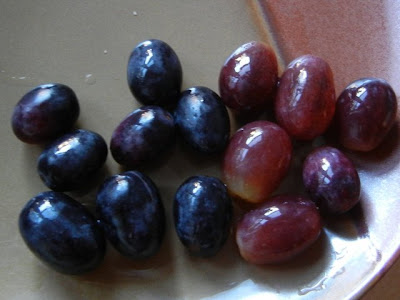Pictured here is a pitcher of iced tea that some of my friends brewed up:

This is Harris Tea's decaffeinated black tea, cold brewed. The two pitchers are the same tea, but the strength of brewing is different; the darker pitcher is obviously stronger.
I found this tea interesting to sample, because it was well outside the zone of teas I would brew up on my own. I tend to avoid decaffeinated tea, instead preferring naturally caffeine-free herbal teas if I am looking for something without caffeine. I strongly prefer loose-leaf to tea bags, and I tend to avoid the brands of tea most commonly available in supermarkets. I also rarely cold brew iced tea, as I find it tends not to produce the results I like the best. For this reason, I wasn't comfortable writing an actual review of this tea on RateTea.
I wasn't crazy about this batch of iced tea. It was perfectly drinkable, but a bit bland. I suspect this tea, however, might taste a bit better to me if brewed the way I would prefer it.
Compared to the worst loose-leaf tea:
As much as I love loose-leaf tea and prefer it to tea prepared in the manner described above, I want to note that my experience with the tea above was still pleasant. I drank a cup of the iced tea, and it was refreshing, only a little bland. There have been some loose-leaf teas that I've brewed up that I've placed great care into preparing, only to pour them out without drinking them because I found them so foul tasting.
I think there's an important life lesson here. Life is a bit unpredictable; sometimes, even if I do everything the way I think is best, things can come out in ways quite different from what I want. At other times, the setup in a situation may seem close to the worst possible, at least by my standards, but things might surprise me by turning out in positive ways.
Delving deeper: what else is going on here?
I think there is one observation about the tea situation here. The tea pictured above was brewed weakly, and I did not expect much from it. When I put care into brewing loose-leaf tea, I usually brew it more strongly, and I usually expect more from it. Thus, it has much greater potential to disappoint.
A life lesson:
I've often found that situations involving people are a lot like this. Sometimes, it seems like I would have a lot in common with someone, but I struggle to relate to them, or find myself coming into conflict with them in odd and unpredictable ways. Sometimes I've been excited about a class or a teacher, only to find that I absolutely hate it, and either drop it or find a way to barely scrape through it.

Other times, I've interact with people from vastly different backgrounds, sometimes even people that others have told me are "difficult to deal with", only to find I get along with these people just fine. I've also taken classes or read books that I did not expect to find remotely interesting (like Numerical Linear Alegbra, or the accompanying text Matrix Computations by Golub) that I ended up finding absolutely captivating.
I think the lesson here is not only that life is unpredictable and full of surprises, but also that delving into something too deep, and becoming heavily vested in a certain outcome of a situation without first getting a taste of that situation, can lead to disappointment. With a cup of tea, you can just pour it out, but in life, sometimes you are stuck with greater consequences to deal with. I find I am both happiest and most productive when I embrace the unpredictability of life, and make decisions in such a way that acknowledges the uncertainties, leaving ample room for both unexpected disliking and unexpected liking.
How about you?
Do you relate to my experience of this batch of iced tea? How about my experiences with life and with people? How about Matrix Computations? Do you get excited about that?
















